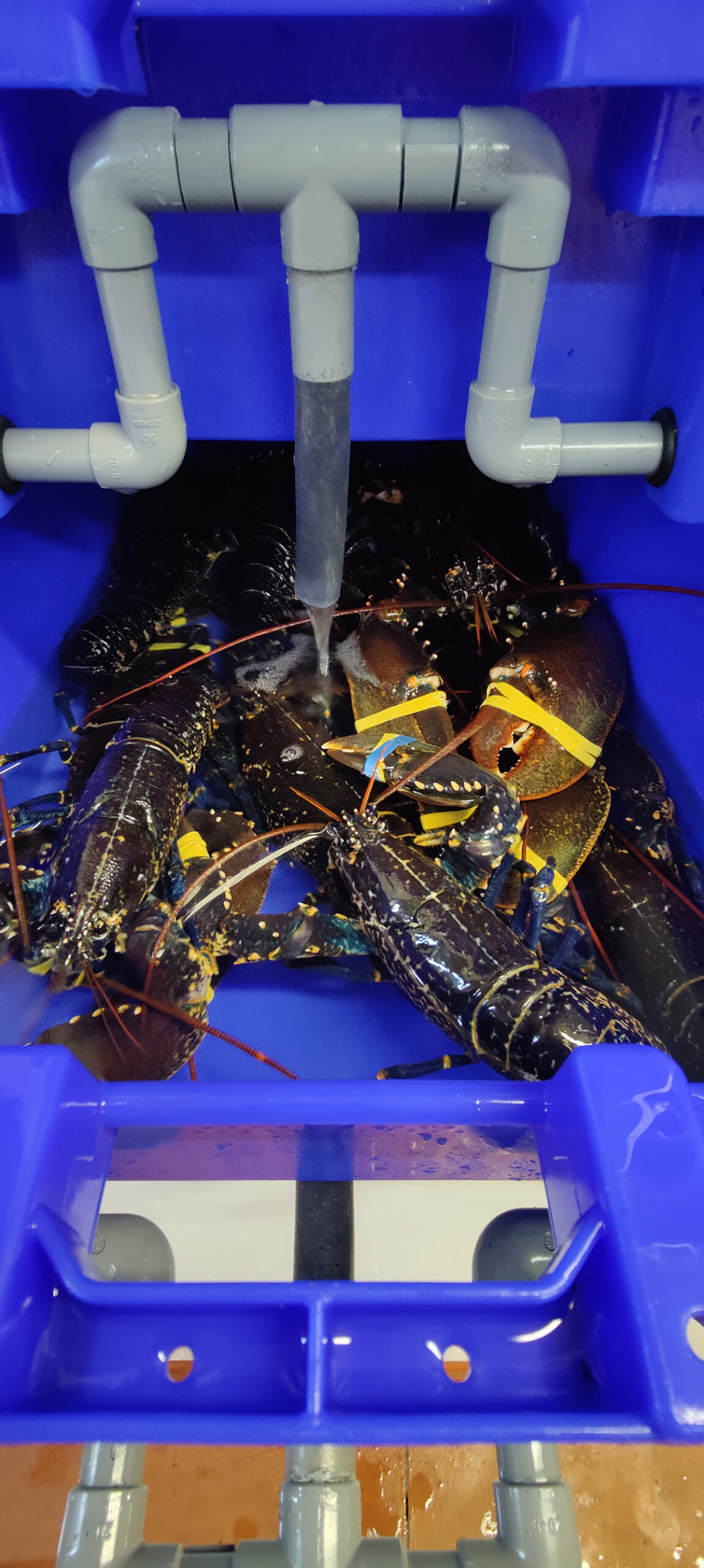Errin Todd continues her series on using seawater tanks to maximise the quality and value of shellfish with a look at long-term storage of lobsters for premium festive sales
Whilst most of our customers use the Lobster Pod and Crab Pod to store their valuable catch of lobster, crab and langoustine and turn it over weekly, there are many who use the systems to hold on to their lobsters for longer to maximise the price for the Christmas market.

Errin Todd.
With the price of lobster ranging from £9 to £32 per kilogram, there is an obvious advantage to holding on to shellfish and selling them at Christmas. It’s the classic supply and demand scenario – with fewer boats working in winter and fewer lobsters on the grounds, the lower volume of landings means that those lucky fishermen and merchants who have holding tanks can capitalise on selling the shellfish at a higher price.
To hold lobsters for months does require a bit more effort. Firstly, your holding tanks should have adequate biological filters to deal with the toxic ammonia the lobsters will produce. Todd Fish Tech systems use a moving bed biofilter with a really effective filter media on which the good bacteria grow. These consume the toxic ammonia and turn it into nitrite, then less toxic nitrate. Without a biological filter, the ammonia levels will get too high and your lobsters will struggle to survive.
You will need to stay on top of your water changes. The nitrate would be consumed in the sea by the seaweed and algae. In a recirculation system, the nitrate will build over time to dangerous levels that will eventually affect the livestock. The only way to decrease the nitrate level in a recirculation system is to do a water change.
We would recommend changing 20% of the water every four to six weeks. Most of our customers use natural seawater, and whilst it is possible to use tap water with a seasalt mix, this can create other challenges with chlorine or chloramine (more on that in another article).
The temperature of your seawater is very important. Between 8°C and 10°C is optimal for storing lobster longer-term. We have conducted scientific trials, and our many customers will agree. Some people in the industry operate tanks at 4°C or 5°C, but at this temperature the lobster is dormant and will not excrete any waste. At this lower temperature, the good bacteria are also dormant and cannot clean any biological waste. You want the lobster to release any waste and relax from the capture so that the meat is tender. It will not do this if the temperature is too low.
The pH of the seawater will reduce over time. The lobster and bacteria use the oxygen in the water and produce carbon dioxide, which is acidic and will reduce the pH. Natural seawater has a pH of 8.2. You should test the pH regularly, and if this is falling you can dose the system with sodium bicarbonate.
It is better to add sodium bicarbonate little and often to gradually raise the pH. We find a mugful per 300kg shellfish capacity Lobster Pod is about right, but it will depend on many factors such as stocking levels, temperature, the alkalinity of the water and oxygen levels. Try to get into a regular routine to keep the pH at optimum levels. If the water is too acidic, it will affect the quality of your lobsters and their ability to survive the delivery process.
If you plan to hold lobster for longer than three months, use cable ties instead of bands. The bands perish after a few months, and will invariably get stuck in your pump impellor. Leave the ends on the cable ties – the lobster like to play with them!
You should always check your stock daily, but this is even more important if you are holding for longer. We would check at the beginning and end of the working day and remove any which are weak to a separate tray in the Lobster Pod – or put them in a basket if you have a tank. The other lobsters are likely to eat any weak ones, and this will really mess up your water quality, so you need to remove any dead or very weak lobsters quickly.
Our systems can store lobsters for up to six months without them losing any weight or condition. This is very important when you are getting a price per kilo. After six months, they will start to use up the fat reserves, starting with their hepato pancreas (the brown meat in the head). You do not want the lobster to lose weight. You can hold them longer, but you would have to feed them, and this will have a detrimental effect on the water quality and the stocking levels.
It used to be that the highest price was achieved at Christmas, but our customers tell us they can now achieve this into the New Year, with the Chinese New Year another high price point. Last year the prices held into March, with a later start to the fishing and low availability of lobster.
Using lobster tanks to hold your catch until it is even more valuable will enable you to maximise your profits. By following these simple tips, you can have a happy Christmas and even merrier new Year.
Case study – Kilkeel Kippering

Rodney and Wayne McCullough with their Lobster Pod system.
Cecil McCullough and his sons Rodney and Wayne are based in Kilkeel and primarily process pelagic fish such as herring and mackerel. They purchased two Lobster Pods storing 600kg of live lobster in spring 2022. Their challenge wasn’t going to be supply, as they are situated right at Kilkeel Harbour, but how they were going to keep the shellfish healthy for the live market.
As this is their first Christmas, they don’t know yet what impact working with the Lobster Pods will have on the price, but they did start holding back stock at the end of October with the hope to achieve double the price for the Christmas market.

Healthy lobsters at Kilkeel Kippering awaiting the lucrative Christmas market.
Rodney said: “We know we have the ability to hold the lobsters for months, so we are confident we will make a good profit. We’re still learning the markets and it’s all still very new to us, but it’s all working great. The viviers are keener for the lobsters now in the run-up to Christmas – whereas before they wouldn’t make the journey unless we had a good quantity of stock, they now come more frequently for less.”
The Lobster Pods have had a positive impact on the price for the live product, which is a bit more than the lobster landed to market.
Rodney said: “We did a fair bit of research and took the time to talk to the manufacturers of the different systems. It was quite clear that Todd Fish Tech’s system was the result of much hard work and studying of the lobster species. It offered the best storage capacity to volume, which suited us well as we had a small area planned for the new shellfish division.”
The McCulloughs like having the ability to sort the catch in any way they please. Rather than having all the lobsters in one big tank where it can get hard to know how long a certain lobster has been there, this system lets them sort the catch by sex, size, the boat it came off or the time it was landed.
Rodney added: “It didn’t take us long to get into the swing of things, and after a bit of care and attention during the filter maturation process, we have successfully been filling our tanks and keeping live healthy lobsters for sale for our buyers’ visits.”
This story was taken from the latest issue of Fishing News. For more up-to-date and in-depth reports on the UK and Irish commercial fishing sector, subscribe to Fishing News here or buy the latest single issue for just £3.30 here.








